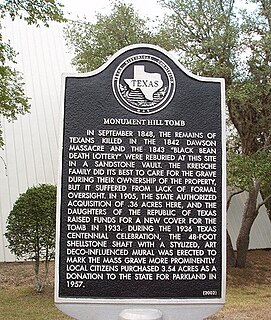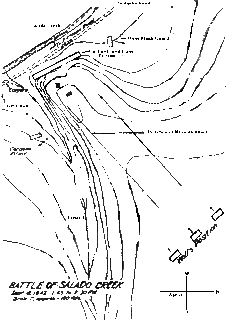 W
WThe Battle of Agua Dulce Creek was a skirmish during the Texas Revolution between Mexican troops and rebellious colonists of the Mexican province of Texas, known as Texians. As part of the Goliad Campaign to retake the Texas Gulf Coast, Mexican troops ambushed a group of Texians on March 2, 1836. The skirmish began approximately 26 miles (42 km) south of San Patricio, in territory belonging to the Mexican state of Tamaulipas.
 W
WThe Battle of the Alamo was a pivotal event in the Texas Revolution. Following a 13-day siege, Mexican troops under President General Antonio López de Santa Anna reclaimed the Alamo Mission near San Antonio de Béxar, killing the Texian and immigrant occupiers. Santa Anna's cruelty during the battle inspired many Texians, both legal Texas settlers and illegal immigrants from the United States, to join the Texian Army. Buoyed by a desire for revenge, the Texians defeated the Mexican Army at the Battle of San Jacinto, on April 21, 1836, ending the rebellion.
 W
WMatthew Caldwell,, also spelled Mathew Caldwell was a 19th-century Texas settler, military figure, Captain of the Gonzales – Seguin Rangers and a signer of the Texas Declaration of Independence. Because of his recruitment ride ahead of the Battle of Gonzales, some call him the Paul Revere of Texas.
 W
WThe Battle of Coleto, also known as the Battle of Coleto Creek, the Battle of the Prairie, and the Batalla del encinal del Perdido, was fought on March 19–20, 1836, during the Goliad campaign of the Texas Revolution. In February, General José de Urrea led a branch of the Mexican army up the Gulf Coast of Mexican Texas toward Goliad, where a large contingent of soldiers from the Texian Army were garrisoned under Colonel James W. Fannin. Simultaneously, Mexican president Antonio Lopez de Santa Anna led a larger force into the Texian interior, where on March 6 his troops won the Battle of the Alamo. After learning of the Alamo's defeat, Texian general Sam Houston ordered Fannin to retreat from Goliad and join the rest of the army in Victoria.
 W
WThe Council House Fight, often referred to as the Council House Massacre, was a decidedly lopsided fight between soldiers and officials of the Republic of Texas and a delegation of Comanche chiefs during a peace conference in San Antonio on March 19, 1840. The meeting took place under an observed truce with the purpose of negotiating the exchange of captives and ultimately facilitating peace after two years of war. The Comanches sought to obtain recognition of the boundaries of the Comancheria, their homeland, while the Texians wanted the release of Texian and Mexican citizens held prisoner by the Comanches.
 W
WThe Dawson massacre, also called the Dawson expedition, was an incident in which 36 Texian militiamen were killed by Mexican soldiers on September 17, 1842 near San Antonio de Bexar. The event occurred during the Battle of Salado Creek, which ended with a Texan victory. This was among numerous armed conflicts over the area between the Rio Grande and Nueces rivers, which the Republic of Texas tried to control after achieving independence in 1836.
 W
WThe Goliad massacre was an event of the Texas Revolution that occurred on March 27, 1836, following the Battle of Coleto; 425–445 prisoners of war from the Texian Army of the Republic of Texas were killed by the Mexican Army in the town of Goliad, Texas.
 W
WThe Great Raid of 1840 was the largest raid ever mounted by Native Americans on white cities in what is now the United States. It followed the Council House Fight, in which Republic of Texas officials attempted to capture and take prisoner 33 Comanche chiefs who had come to negotiate a peace treaty, killing them together with two dozen of their family and followers. The Comanche tribe was supposed to have brought white hostages as their part of the negotiations but only brought one young woman. Arguments and fighting then broke out among the Texians and Comanches. The Texas Officials were determined to force the Comanche to release all white captives among them. To avenge what the Comanche viewed as a bitter betrayal by the Texans, the Comanche war chief Buffalo Hump raised a huge war party of many of the bands of the Comanche, and raided deep into white-settled areas of Southeast Texas.
 W
WThe Mier expedition was an unsuccessful military operation launched in November 1842 by a Texian militia against Mexican border settlements; it was related to the Somervell expedition. It included a major battle at Ciudad Mier on December 26 and 27, 1842, which the Mexicans won. The Texian attack was launched partly in hopes of financial gain and partly in retaliation for the Dawson Massacre earlier that year, in which thirty-six Texas militia were killed by the Mexican Army. Both conflicts were part of continuing efforts by each side to control the land between the Rio Grande and Nueces River. The Republic of Texas believed that this territory had been ceded to it in the Treaties of Velasco, by which they gained independence; but Mexico did not agree.
 W
WThe Battle of Plum Creek was a clash between allied Tonkawa, militia, and Rangers of the Republic of Texas and a huge Comanche war party under Chief Buffalo Hump, which took place near Lockhart, Texas, on August 12, 1840, following the Great Raid of 1840 as the Comanche war party returned to west Texas.
 W
WThe Battle of Refugio was fought from March 12–15, 1836, near Refugio, Texas. Mexican General José Urrea and 1,500 Centralista soldiers fought against Amon B. King and his 28 American volunteers and Lieutenant Colonel William Ward and his approximately 120 Americans. The battle, a part of the Goliad Campaign of the Texas Revolution, resulted in a Mexican victory and splintered Texan resistance.
 W
WThe Battle of Salado Creek was a decisive engagement in 1842 which repulsed the final Mexican invasion of the Republic of Texas. Colonel Mathew Caldwell of the Texas Rangers led just over 200 militia against an army of 1,600 Mexican Army soldiers and Cherokee warriors, and defeated them outside of San Antonio de Bexar along Salado Creek. As a result of this action, French-Mexican commander General Adrián Woll retreated south and back into Mexico.
 W
WThe Battle of the San Gabriels was an 1839 skirmish in the Texas–Indian wars.
 W
WThe Battle of San Jacinto, fought on April 21, 1836, in present-day Houston, Texas, was the decisive battle of the Texas Revolution. Led by General Samuel Houston, the Texan Army engaged and defeated General Antonio López de Santa Anna's Mexican army in a fight that lasted just 18 minutes. A detailed, first-hand account of the battle was written by General Houston from the headquarters of the Texan Army, San Jacinto, on April 25, 1836. Numerous secondary analyses and interpretations have followed.
 W
WThe Battle of Stone Houses was a skirmish between Texas Rangers and a band of Kichai Indians which took place on November 10, 1837. The skirmish, which took place ten miles south of what is now Windthorst, Texas, was named for three stone mounds near the battlefield which appeared to the Indians to be small houses.
 W
WThe Battle of Village Creek occurred on May 24, 1841, on the embankments of Village Creek. The battle, which evolved into a running gunfight between the Republic of Texas militia and the Village Creek tribes, was attributed to the increased Native American raids on Anglo settlements in the Red River counties.